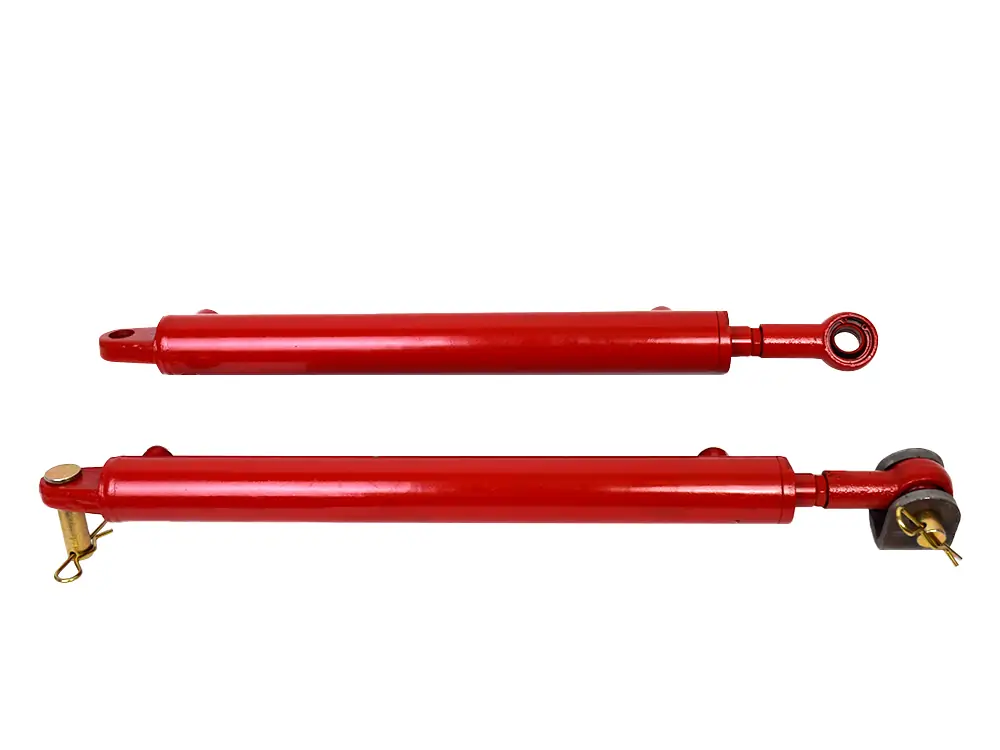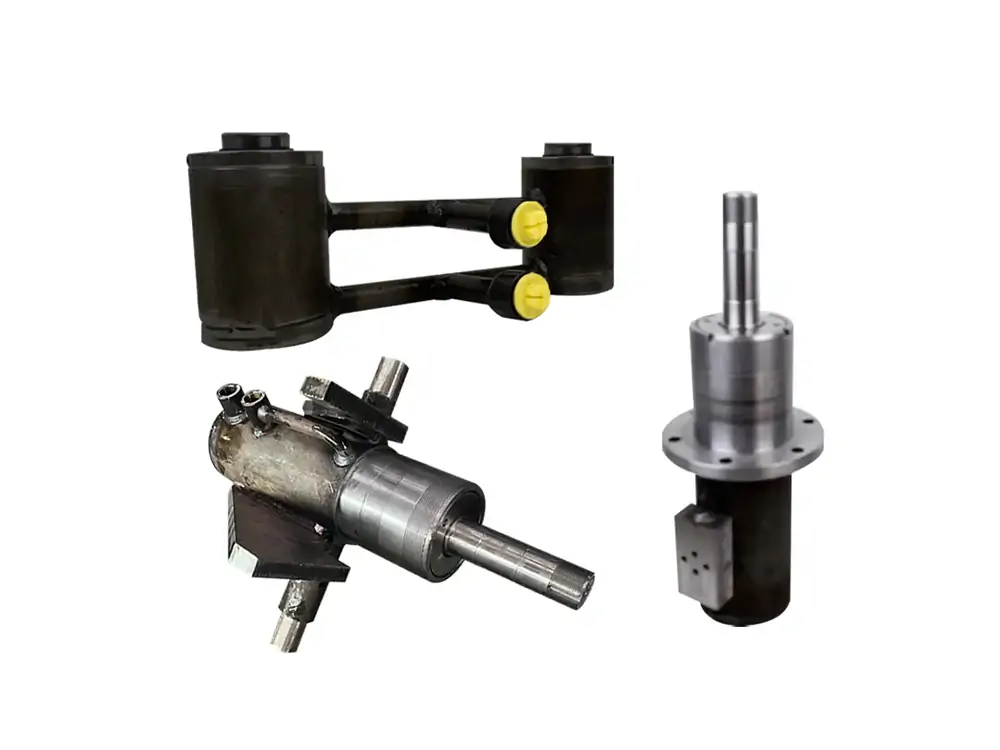Introduction
Are you wondering about the decreased efficiency of the hydraulic cylinders? Maybe there is a wearing out of the hydraulic components. One of the significant reasons for decreased hydraulic equipment performance is the air trapping inside the hydraulic cylinder.
So, how can you avoid the hydraulic cylinder air trapping? How do you bleed the double-acting hydraulic cylinder? Today, we will discuss all the tools required in detail. Let’s explore.
What is a double-acting hydraulic cylinder?
A double-acting hydraulic cylinder is famous for its dual-force implementation. It not only extracts the hydraulic rod but also retracts.
There are two ports.
- Extension Port. It supplies fluid to the rod and extends it.
- Retraction Port. The retraction of the rod is possible with the hydraulic fluid.
Unlike the single-acting hydraulic cylinder, the hydraulic fluid is the main player without applying an external force.
Why should you bleed the double-acting hydraulic cylinder?
Suppose air is trapped in the hydraulic cylinder. What do you think it can do? It affects almost all the systems and can decrease the lifespan of your hydraulic cylinders.
It can cause the following disturbances that require the ultimate bleeding of the hydraulic cylinders.
Irregular Movements
The hydraulic cylinder relies on the movements of the hydraulic fluid. What if your hydraulic system comprises the air? The fluid flow will be irregular. It will result in unbalanced force applications.
Air pockets will cause the jerky movements of the double-acting hydraulic cylinders and often cause accidents.
Loss of Power
Whenever air is in the system, there is no compressible force. The system generates a consistent force that ensures smooth power generation.
What happens when the air is inside? It will result in improper force generation. The ultimate result will be the irregular force that fails to deliver the expected power.
Increased Wear and Tear
Since the whole motion of the hydraulic system is disturbed, it causes stress on other components. The resultant strain for a longer period turns new components into older and worn-out ones. The speedy wear and tear of the hydraulic tools is a financial loss for the owners.
System Inefficiency
Air reduces the overall system functionality. What if your hydraulic system is not working? What will you expect? A decreased efficiency, right? That is what happens in the case of air in the system.
Cavitation and Damage
Excessive air causes the cavities in the cylinders. Whenever the fluid flows, it forces the air into the surrounding systems. As a result, the vicious cycle of damage and cavitation goes on.
Tools and materials required to bleed the double-acting hydraulic cylinders
You must have the necessary tools and equipment for bleeding the double-acting hydraulic cylinders. Here is the complete list of tools required for this purpose.
- Wrenches or spanners. They will help loosen the fittings to fix air issues and then tighten them to avoid air entry in the future.
- Fluido hidráulico. It provides sufficient power and might need to be used in bleeding. You must purchase the matching liquid to avoid issues.
- Safety gloves and goggles. They can help ensure safety when removing air from hydraulic cylinders.
- Bleeder valve or plug. This valve helps remove the trapped air efficiently.
- A clean container helps remove the hydraulic fluid and the air bubbles.
- Rags or absorbent materials are helpful when you need neat and clean bleeding of the hydraulic cylinder.
- Hydraulic pumps or power sources are additional tools required to handle the hassle of double-acting hydraulic cylinder bleeding.
Step-by-step instructions to bleed the double-acting hydraulic cylinder
When bleeding the double-acting, you have to consider all the aspects. Think of the safety measures. Assess the hydraulic cylinders before taking on more hassles. Know the step-by-step guide to bleed the hydraulic cylinder.
Step 1: Safety precautions
Safety first!
Before you bleed the hydraulic cylinder, it is better to know the safety conditions. Here are a few tips to ensure safety and avoid any accidental cases.
- Turn off your hydraulic cylinders and depressurize them before starting your first activity.
- Ensure your safety by purchasing quality goggles and wearing them. They will keep you from hydraulic fluid spills or leaks.
- Stabilize the hydraulic cylinder by choosing a safe and stabilized place. Ensure there are no issues or movements when working.
- Inspect the hydraulic cylinder. Are there any leaks? Correct them instantly.
Step 2: Inspect and Find Bleeder Valves
One of the best things about the quality hydraulic cylinders is their bleeding valves. Do you have double-acting hydraulic cylinders that have bleeder valves?
Opening these bleeder valves facilitates easy bleeding. What if there are no bleeder valves? Opening the fittings is ideal in other cases.
Step 3: Extend and pressurize the hydraulic cylinder
Select the hydraulic cylinder extension port and connect it with the hydraulic pump. Apply the pressure to fully extend the hydraulic cylinder.
In that case, the air will be at the retraction port. At least, you’ll find the location of the air and take further steps to remove it.
Step 4: Remove the Air in the Extension
There are two options to remove the air. Remember to keep the hydraulic cylinder pressurized.
- Open the bleeder valve.
- Loosen the hydraulic fittings.
Whatever method you try, the air will escape from the system. How can you confirm it? You’ll hear a hissing sound from the hydraulic retraction component or hydraulic fittings, or you’ll get the air bubbles popping out of your clean container.
Tighten the fittings when there is no bubble coming!!
Step 5: Pressurize Hydraulic Cylinder at Retraction
Now, repeat the same procedure in the retraction port. Here is the list of steps to follow.
- Connect the hydraulic pump to the retraction port and apply the pressure.
- The air will rise to the opposite end while fluid will be at the retraction port.
- Apply the pressure significantly until the whole air is at the retraction port.
Step 6: Removal Of Air At Extension
Again, you have two options.
- Open the bleeder valve and observe the air removal. Hissing or air bubbles will confirm the air removal.
- If your hydraulic cylinder doesn’t have the bleeder valves, you better loosen your fittings with the screws.
Assess and tighten only when 100% of the air is removed from the retraction area of the hydraulic cylinder.
Step 7: Check and Repeat Cycle
It is not a one-time job. Instead, you must repeat the cycle multiple times until there is no air.
Once you are sure there is no air, check the fluid levels. If there is less liquid in the hydraulic, don’t hesitate to refill the system until the required levels of the hydraulic fluids are there.
Step 8: Inspect the system for Leaks
There is a final step to focus on. You have to consider the inspection as your final step.
- Check the hydraulic cylinders.
- Look for any leakage points.
- Assess fluid levels.
- Check the smooth operation of the hydraulic cylinders.
In all cases, if you get the normal functionality of the hydraulic cylinders, you have successfully removed the air. Go on checking the system at regular intervals, weekly or monthly.
Troubleshooting Bleeding Issues
| Problem | Solution |
| Persistent air bubbles in the system | Recycle the cylinder multiple times; bleed both ports carefully. Check for leaks in hoses or fittings that might allow air ingress. |
| Jerky or uneven cylinder movement | Ensure the system is fully bled. Verify hydraulic fluid is clean and free of contaminants. Recycle the cylinder again. |
| Excessive fluid loss during bleeding | Tighten fittings securely to prevent leaks. Use absorbent material to clean up fluid spills. |
| Bleeder valves not available | Loosen hydraulic fittings at the ports carefully to bleed air without removing them completely. |
| Air re-entering the system | Inspect the hydraulic hoses, fittings, and seals for damage. Replace faulty components to eliminate air ingress. |
Tips to Prevent the Air Trapping inside the Hydraulic Cylinder
Air contamination is toxic for your double-acting hydraulic cylinders. You can prevent air trapping and keep the seals intact. Here are a few tips to avoid air trapped inside hydraulic cylinders.
Regular maintenance
Regular inspection can trace all the leaks and cracks in the hydraulic cylinders. It will keep you from damage and avoid air entry into the system.
Proper sealing
Check the seal. First, get quality hydraulic cylinders from suppliers like QuanYe Hydraulic Cylinder manufacturers. However, you can closely assess the seals and correct them occasionally.
Clean hydraulic fluid
Hydraulic fluid contamination can also be a problem for the hydraulic cylinders. Use high-quality hydraulic fluid that gives the next-level protection from the air.
Install Air Bleeder Valves
If your hydraulic cylinder doesn’t have the bleeder valves, it is better to add one. It helps better maintain your hydraulic cylinders.
Conclusión
When bleeding a double-acting hydraulic cylinder, keep an eye on the functionality. Avoid the tightening of the system and ensure there is no air. However, there is another possible solution in this case. You can purchase a quality hydraulic cylinder that doesn’t let the air trapped in the system.
Where can you get that one? QuanYe Hydraulic Cylinder manufacturer is the ideal stop for your hydraulic equipment. You get the premium quality of double-acting hydraulic cylinders and explore a wide range of products. Take a look at the collection now!
Meta Title: Step-by-step Instructions to
Meta Description: There are two options if you want to bleed the double-acting hydraulic cylinders. We have discussed both options in different steps. Read on to know.







